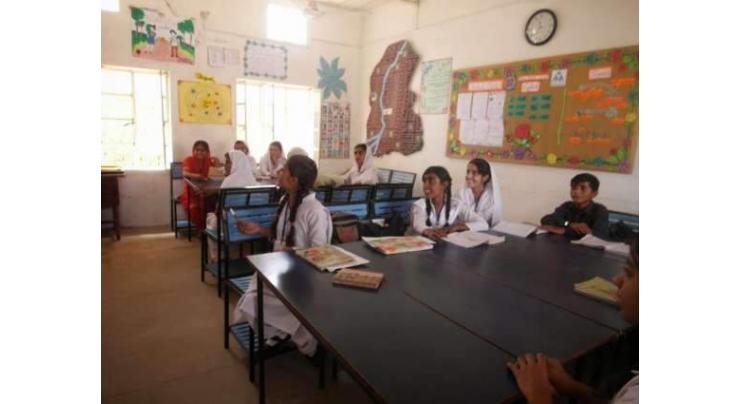
Achieving 90pc Literacy, An Illusive Vision 2025 Target: Experts
Faizan Hashmi Published June 19, 2018 | 08:12 PM

The Vision-2025 goal to achieve 90 percent literacy rate in the country by 2025 appears to be an illusive target as the existing number of feeder schools and literacy centres of NCHD lag far behind the required standard.
ISLAMABAD, (UrduPoint / Pakistan Point News - 19th Jun, 2018 ) :The Vision-2025 goal to achieve 90 percent literacy rate in the country by 2025 appears to be an illusive target as the existing number of feeder schools and literacy centres of NCHD lag far behind the required standard.
"The National Commission for Human Development (NCHD) needs 300,000 schools to achieve 90 percent literacy rate target in the country under the Vision-2025," Expert consultant at National Training Institute (NTI), Iqbal ur Rehman said here Tuesday.
Talking to APP he said though the center has been striving hard to establish feeder schools to help meet the literacy targets, however, so far it has been successful in building up only 5,567 schools, which depicts the slow pace of work being executed for improving literacy across the country.
Iqbal being an education expert suggested that the current working system of NCHD had other certain limitations to achieve the 90 percent literacy rate.
It had to increase its manpower and staff capacity besides enhancing quality of education and services rendered by its various institutions and departments across the country.
He was of the view that the commission had been successfully executing its policies and programmes including Adult Literacy Programme for the mothers and Universal Primary Education through its feeder schools, Madrassa School Project, Literacy for Jail project and National Training Institute.
The NCHD, he said, successfully enrolled 272,289 students in its adult literacy centres and educated 3.8 million illiterates, however the literacy rate was increasing at snail's pace with only 1 percent annual growth.
Iqbal was optimistic about the changes taking place in the education sector, saying that more than 90 percent of the students enrolled in the adult literacy programme were women belonging to rural areas of the country.
The women particularly mothers after getting education in the literacy centres had discovered new prospects while it had made their life convenient and they had started sending their children to schools, he said.
He said the out of school children was one of the serious issues for the policymakers to focus on, while the women getting education under NCHD literacy programmes were proving to be a helping hand in that regard as they had started their children getting enrolled in schools.
Bilal Aziz, an education expert meticulously observed the commission's policies and projects striving to achieve the Vision-2025 goal of 90 percent literacy rate across the country.
He believed that NCHD at present had above 5,000 feeder schools in various districts of the country to impart knowledge and basic skills to illiterate population, while according to its own policy the commission had to develop thousands more schools to achieve the target.
He made it clear that at current pace of the literacy centers and other projects working to achieve the set target, the possibilities grow short which needs to be addressed. He, however, criticized NCHD for dealing all the provinces with same stick despite the fact these vary in literacy rate, as Punjab was having higher literacy rate compared to other provinces.
He said Balochistan and Punjab had different literacy rates, 60 percent and 25 percent respectively, while both had to achieve 90 percent literacy by 2025, which seemed illogical as in that scenario, it was a challenge for the province with least literacy rate and limited resources to match the pace of the province with galloping literacy rate, he added.
Aziz said no doubt NCHD had given maximum attention to rural areas where sustainable results had been attained but the objective examination of the existing literacy rates in all the provinces of the country demanded reappropriation of the resources and policy to meet the big challenge.
He opined that NCHD should develop need-based policies and resource allocation to achieve 90 percent literacy rate across the country; accommodating each province in accordance with its educational requirement and literacy rate.
Related Topics
Recent Stories

Delegation of international investors meets Finance Minister

Federal Govt stands with Balochistan for its development: Naqvi

UAE President receives condolences of Prime Minister of Pakistan over passing of ..

ECC approves to enhance wheat procurement targets

UN urges Israel to 'stop escalation' as tanks enter Gaza's Rafah city

EU stumps up $125 mn for Yemen after aid groups' plea

Governor Tessori condemns May 9 riots, calls it a 'pre-planned conspiracy'

PM condoles with UAE President over Sheikh Tahnoun’s death

Milan nets Giro 4th stage, Pogacar retains lead

UBS back in profit after Credit Suisse takeover losses

Asiya Gul lauds Shafaat's services as DG LG

President for dialogue with all political forces in Balochistan
More Stories From Pakistan
-
Mohsin Naqvi pays surprise visit to NADRA center
39 minutes ago -
May 9 vandalism against state of Pakistan: Muqam
2 hours ago -

Federal Govt stands with Balochistan for its development: Naqvi
2 hours ago -

Governor Tessori condemns May 9 riots, calls it a 'pre-planned conspiracy'
2 hours ago -

PM condoles with UAE President over Sheikh Tahnoun’s death
2 hours ago -

Asiya Gul lauds Shafaat's services as DG LG
2 hours ago
-

President for dialogue with all political forces in Balochistan
4 hours ago -

Supreme Court adjourns IHC judges letter case
4 hours ago -

RDMC, Hunar Foundation Vocational Training Center inaugurated in Nokkundi
4 hours ago -

Man critically injured as vehicle catches fire amid CNG filling
4 hours ago -

Provincial health ministers chair meeting of Punjab Blood Transfusion Authority
4 hours ago -

Sheikh Jafar Khan Mandukhel assumes charge as Governor Balochistan
4 hours ago









